#naturalist's library
Explore tagged Tumblr posts
Text
Léon Bakst
1866–1924
Costume design for a nymph in The Afternoon of a Faun (L’Après-midi d’un Faune), 1912
Watercolor, pencil, and gold paint on paper
Harvard Theatre Collection, Houghton Library, Howard D. Rothschild Collection; pfMS Thr 41.4 (5)

#léon bakst#1866–1924#Costume design for a nymph in The Afternoon of a Faun#L’Après-midi d’un Faune#1912#Watercolor#pencil#and gold#paint on paper#Harvard Theatre Collection#Houghton Library#Howard D. Rothschild Collection#pfMS Thr 41.4 (5)#artist painter#original art#art#art work#art style#ilustration painter#art colors#naturalist painter#watercolor colors#oil on panel#woodblock print#woman’s art#frank murdoff#ooctoopussy#xpuigc#xpuigc bloc
13 notes
·
View notes
Text

Second day of physiology studies
#ufpe#college student#100 days of productivity#motivation#naturalist biologist#studyblr#academic#study aesthetic#study academia#libraries#physiology#biology#student life
24 notes
·
View notes
Text
Happy #InternationalSlothDay!
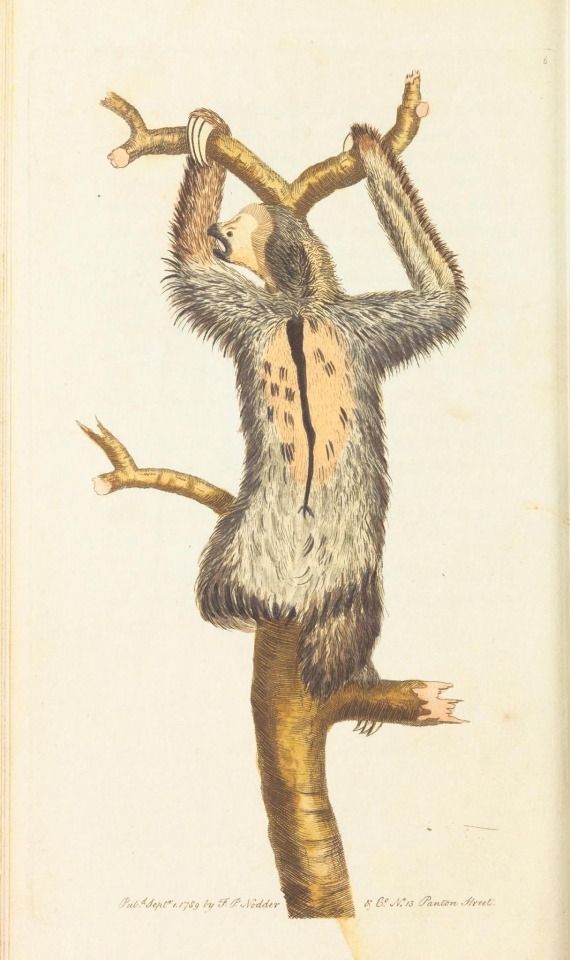
George Edwards’ male Pale-throated Sloth (Bradypus tridactylus) from The Naturalist’s Miscellany Vol. 1, 1789, looking rather offended! This is probably because it read the rude things being written about it in the accompanying text:
“So extraordinary is the union of awkwardness and ugliness in this uncommon creature, that it has generally been regarded as one of the most striking examples of animal deformity.” 🤨
“A celebrated naturalist, the Count Buffon, will not allow this creature to have any share in contributing to the general beauty in the chain of beings, but regards it as an ill-constructed mass of deformity, created only for misery….” ☹️
“With submission, however, to this lively naturalist, I should not hesitate to believe that the sloth, not withstanding this appearance of wretchedness and deformity, is as well-fashioned for its proper modes and habits of life, and feels as much happiness in its solitary and obscure retreats, as the rest of the animal world of greater locomotive powers and superior external elegance.” 🤷🏻♀️
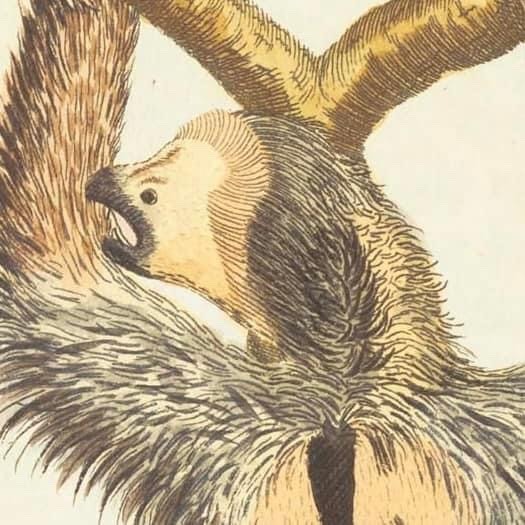
via Biodiversity Heritage Library
#animals in art#european art#animal holiday#illustration#18th century art#George Edwards#The Naturalist’s Miscellany#BHL#Biodiversity Heritage Library#natural history art#scientific illustration#sloth#International Sloth Day#lithograph#Pale-Throated Sloth
13 notes
·
View notes
Text
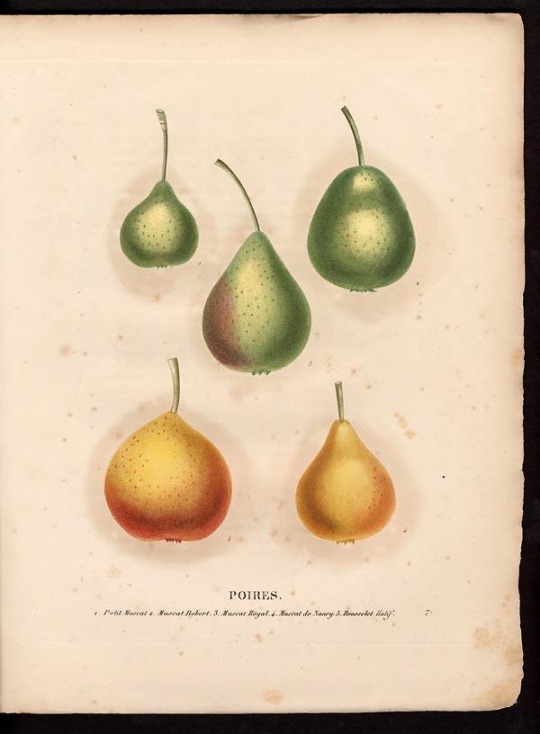

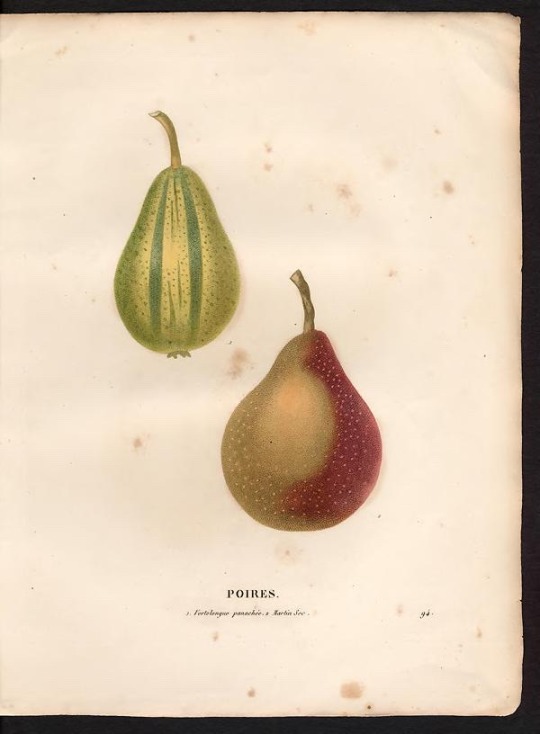

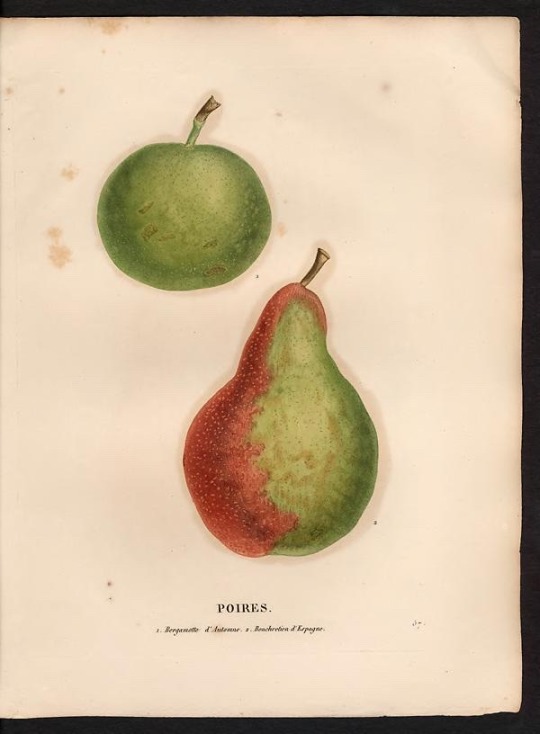
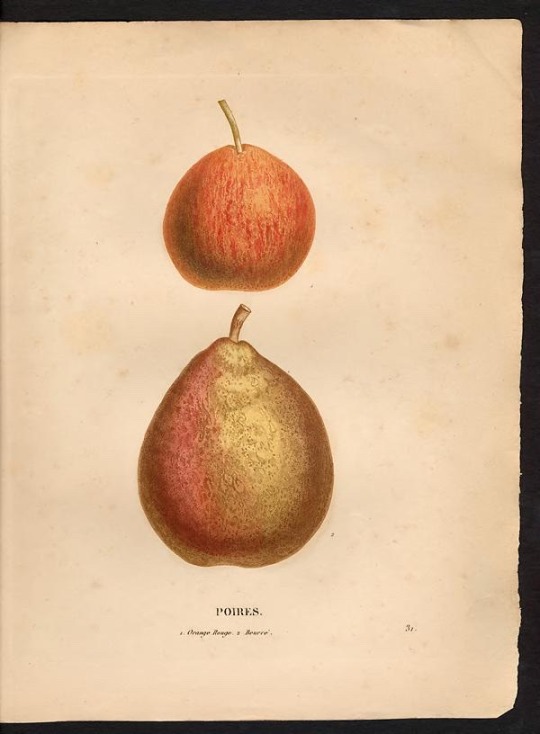
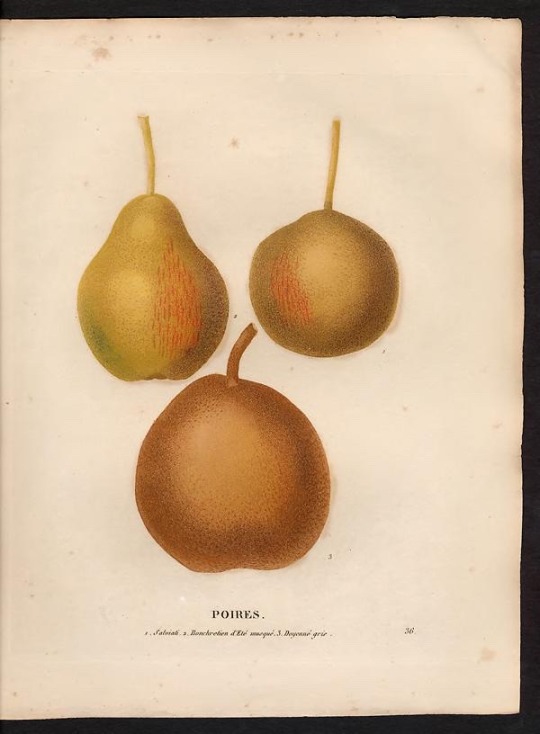


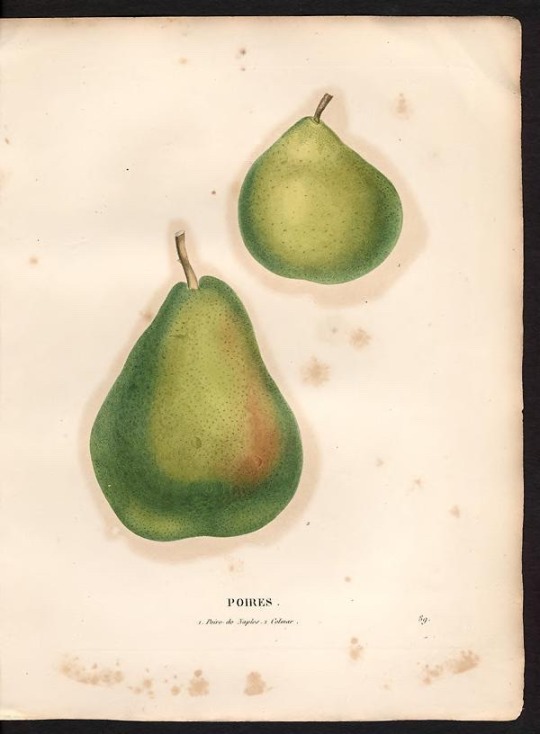
Pears of France / Poires
La flore et la pomone françaises : histoire et figure en couleur, des fleurs et des fruits de France ou naturalisés sur le sol français, 1828
Artists: Jaume Saint-Hilaire, Jean Henri (illustrations).; Didot, Firmin (printing)
#my posts#firmin didot#didot#Jaume Saint-Hilaire#Jean Henri Jaume Saint-Hilaire#pears#France#fruit#illustration#vintage#flora#naturalist#botany#botanist#vintage book#antique#pear#vintage botanical prints#botanical prints#floral prints#vintage floral prints#prints#Wikipedia commons#biodiversity heritage library
2 notes
·
View notes
Text
Bowdoin College, academia, and the two Alpheus Spring Packards

Left: Engraved illustration of Alpheus in 1882 from History of Bowdoin College: with biographical sketches of its graduates from 1806 to 1879, inclusive (also Wikimedia). Right: Illustration of his son of the same name in 1888 from Popular Science Monthly Volume 33 (also Wikimedia)
In an interesting twist of fate, there are two Alpheus Spring Packards who are my ancestors. One of them, Alpheus Spring Packard, Sr. (1788-1884), is my 3rd cousin, 6 times removed. The other, his son, Alpheus Spring Packard, Jr. (1839–1905), is my fourth cousin 5 times removed. In this post I'll examine each of them and explain how they are different from one another, and note their similarities.
Alpheus Sr., as he will be called for the rest of this article, was born on December 23, 1798 in Chelmsford to a reverend, Hezekiah Packard (1761-1849), and Mary Spring (1773-1829). At the time of his birth, he was an only child. He would be joined, by 1816, by five siblings: George Thomas (1803-1876), Hezekiah (1805-1867), Sarah Spring (1808-1894), Joseph (1812-1902), and William (1816-1834).
He was educated at home, educated from Bodwin College in 1816, and became tutor in Bodwin College in 1819. A few years later, in 1824, he became professor of Greek and Latin, staying as such until 1865. He later became a religious professor in 1864, wrote many publications, and even served as college librarian. There was much more to his life than this simple biography. In June 1827 he wedded a 23-year-old woman, Elizabeth Frances Appleton, said to be a "woman of rare excellence". Unfortunately, their marriage was short-lived, as she would die 12 years later in June 1839. [1] Before that time, they would have five children: Charles Appleton (1828-1909), William Alfred (1830-1909), George Lawrence (1834-1916), Frances Appleton (1837-1902) (herein Frances A.), and Alpheus (1839-1905). The latter will later be described in this article as Alpheus Jr. or known as "Alpha" for short.
A few years after Elizabeth's death, in September 1844, and at age 45, Alpheus Sr. would marry again in Portland, Maine, this time to woman named Caroline McLellan, who was over 15 years younger than him! They would have one child: Robert Lawrence (1847-1913). Caroline married one time before to a man named Peter Osgood McLellan in 1836, with her original name as Caroline W Bartels, named after her father John Bartels. Her first husband, Peter, had died five years before in September 1839. [2]
Despite the fact that Alpheus Sr. and Caroline only beared one son, Robert Lawrence, as noted earlier, she lived most of her life, from age 30 to age 70, with Alpheus Sr. She even lived beyond him to 1893, to the ripe old age of 79, and was buried in Brunswick. She would be a mother of sorts to the children from the previous marriage of Alpheus Sr. with Elizabeth. At the time of Elizabeth's death, Charles Appleton was only 11, William Alfred was nine, George Lawrence was five, Frances A. was two, and Alpheus Jr. was not even one year old. In 1850, all of them were living together in Brunswick, Maine, along with George O. McLellan, the 12-year-old son Caroline had with her husband, Peter, and a 17-year-old woman named Joanna Sillers. [3]
In 1860, the household of Caroline and Alpheus Sr., still in Brunswick, would include Caroline's son, George O., now a seaman, Alpheus Jr., their son Robert L., and an Irish servant named Winifred Leonard. Alpheus Sr. would have real estate worth $2,000 and personal estate worth $1,000. [4] Unlike in 1850, Charles A., the engineer, and William A., as a student, were not in the household. Neither were Frances A. or Joanna Sillers. By 1870, the household had changed again. A 62-year-old woman, Rebecca P., and her seeming 31-year-old daughter, Charlot M., were in the same house as Alpheus Sr., Caroline, and Frances A. The real estate owned by Alpheus Sr. had grown to $3,500 while his personal estate was $7,500, much more than the combined real and personal estate owned by Rebecca, numbering at $3,000. A deeper dive shows that Charlot M. refers to Charlotte Mellen (1838-1923), the daughter of Charles Packard (1801-1864) and Rebecca Prentice Kent (1808-1905). A clergyman, Charles was another brother of Alpheus Sr., who was living in Biddlefield, Maine with Rebecca, and their children, Charlotte, in 1860, and in Lancaster, Worcester, Massachusetts in 1850. [5]
By 1880, the household would be small. Frances A. would be living with her mother of sorts, Caroline, and father, Alpheus Sr., in Brunswick. Also, an 18-year-old Irish servant named Margaret Cusick would be living in the same household. [6] This is the last census Alpheus Sr. appears in, as he died in 1884. By that time, he had also corresponded with Charles Darwin, taught writers like Nathaniel Hawthorne (1804–1864) and Henry Wadsworth Longfellow (1807–1882), was acting President of Bowdoin College from 1883 to 1884, wrote 25 publications, and was key figure in the Maine Historical Society, along with a literary society known as the Peucinian Society and other historical societies. He would die on Squirrel Island of heart disease while on a trip with his family and be buried in Brunswick's Pine Grove Cemetery. He was said to be involved in the anti-slavery and temperance movements as well. [7]

Undated via wikimedia and illustration of him in 1905
Alpheus Jr. would be different. He was born in February 1839 in Brunswick, Maine, and the last child of Elizabeth and Alpheus Sr. By age 21, in 1860, he was a student, likely at Bodwin College. He would marry a 25-year-old woman named Elizabeth Derby Wolcott a few years later in Salem, Massachusetts. By 1870, he and Elizabeth would be living in a house headed by 67-year-old woman, Martha P. Wolcott, and include a 36-year-old mariner named Samuel P. Wolcott, a presumed one-year-old daughter named Martha M., and two servants: 60-year-old Irish man named Daniel McDoregh and his 50-year-old wife Bethsheba, from Massachusetts. Martha was the mother of Elizabeth, while Samuel was likely Elizabeth's brother. It is curious that in 1860, Bethsheba was living with Elizabeth and her family, as was a man named John, who may be the same as Daniel. [8] In the 1870 census Alpheus Jr. is curiously listed as a naturalist.
That occupation was fitting. By 1870 he had already published works about collection and observation of insects, study of languages, Socrates, the Bunker Hill Monument, and how insects could benefit and harm crops. This would be the beginning of his career as an "eminent zoologist", which would lead him to become professor of zoology and geology at Brown University in 1878, building upon his role as custodian of the Boston Society of Natural History from 1855 to 1865 and connection with the Peabody Academy of Science from 1865 to 1876. He was also Massachusetts state entomologist from 1871 to 1873 and editor-in-chief of the American Naturalist for 29 years! [9]
By 1880, Alpheus Jr., Elizabeth, and their children were in the same household, now in Providence. Their children included Martha Walcott (1868-1956), who was at school, Alpheus Appleton (1871-1948), Elizabeth Darby (1877-1885), and Frances Elizabeth (herein Frances E.) (1880-1971). There were also two Irish domestic servants in the household: 20-year-old Bridget Maguire and 30-year-old Ellen Donahue. [10] By this point, Alpheus Jr. had published even more works, this time on Mammoth Cave, common insects, life histories of animals, zoology textbooks, and insects that can harm shade trees. Since no full census for 1890 exists, we can't say for sure what was happening at that time. However, we do know that by 1900 he had published books about geology, cave fauna, entomology, the Labrador Coast, French philosopher Jean-Baptiste Lamarck, a volcano in Sicily, and prehistoric tombs in eastern Algeria. A sketch of him written in 1888 in Popular Science Monthly notes his naturalist expeditions over the years, that he served for three years as assistant surgeon in the First Regiment of Maine Veteran Volunteers from 1863 to 1865, and said to have a "very pleasant and entertaining companion".
In 1900, the census enumerators described him as a professor of zoology. He lived in Providence that year with his wife Elizabeth and their children Mary W., Alpheus A., and Francis E., along with an Irish servant named Ritta Hackett. This is the last census he would appear in. By 1903 he was said to have written over four hundred geological and zoological works, and living at 275 Angell Street. He also was said to have grey eyes, tall, very slight, and was an immaculate dresser. [11]
A sketch by Albert Davis Mead of Alpheus Jr. after his death, in February 15, 1905 from an ulcerated tooth, causing necrosis to develop and septic poisoning, would describe him as an American naturalist. It would also praise his "sterling quality and the wide range of his life work", note his lineage, and praised his "scientific career". [12] He had also been a member of American Philosophical Society. There was even a 1920 biographical memoir of Alpheus Jr. written by T.D.A. Cockerwell. That book notes his lineage, that while in Brunswick an unnamed "maiden lady" assisted him about shells and naming native plants, while a Miss Ann Jackson told him about Lamarck as a boy, and notes that Alpheus Jr. "never knew his mother" due to her death when he wasn't even a year old. It also reveals that his aunt, Sarah, took charge of the household in the wake of the death of the mother of Alpehus Jr., and notes his antislavery sentiments, even at a young age, although there is some racist anti-Kurdish views mixed in there. At the same time, it reveals his use of local libraries as a form of self-education, excerpts from his diary, and his naturalistic trips, support of evolution, and more. [13]
In the years following Alpheus Jr.'s death, his wife Elizabeth would move to Haverhill Ward in Essex, Massachusetts, in 1910 living in a household headed by Percy W. McClellan and Frances E. By 1920 she would be seemingly be living in Andover with her daughter Martha, and a 51-year-old boarder named Lara Black. [14] In the end, there were similarities between the two Alpheus Packards, but also differences which separated them from each other, with Alpheus Jr. called Alpha in his early life, and had his own life separate from his father.
Notes
[1] "Death of Prof. Packard - Jul 17, 1884 obit" clipping from The Republican Journal, Belfast, Maine, 17 Jul 1884, Page 2; Francis E. Appleton in the Massachusetts, U.S., Marriage Index, 1784-1840, Index of Marriages in Massachusetts Centinel and Columbian Centinel 1784 to 1840, page ****94, American Antiquarian Society. Index to Marriages in Massachusetts Centinel and Columbian Centinel, 1784-1840, Vol. 1 A-D. Boston, MA, USA: G.K. Hall, 1961; Frances E. Appleton in the Massachusetts, U.S., Compiled Marriages, 1633-1850; Family History Library; Salt Lake City, UT; Film # 0818093-0818095, Dodd, Jordan, Liahona Research, comp. Massachusetts, Marriages, 1633-1850; Frances A Packard in the Massachusetts, U.S., Marriage Records, 1840-1915, New England Historic Genealogical Society; Boston, Massachusetts; Massachusetts Vital Records, 1911–1915, Massachusetts Vital Records, 1840–1911. New England Historic Genealogical Society, Boston, Massachusetts, Massachusetts Vital Records, 1911–1915. New England Historic Genealogical Society, Boston, Massachusetts; Nehemiah Cleaveland, History of Bowdoin College: with biographical sketches of its graduates from 1806 to 1879, inclusive (ed. Alpheus S. Packard, Boston: John Ripley Osgood & Company, 1882), 188-190.
[2] Caroline W Bartels in the Massachusetts, U.S., Town and Vital Records, 1620-1988, Town and City Clerks of Massachusetts. Massachusetts Vital and Town Records. Provo, UT: Holbrook Research Institute (Jay and Delene Holbrook), image 10071; Peter Osgood McLellan in the U.S., Newspaper Extractions from the Northeast, 1704-1930, Newspapers and Periodicals. American Antiquarian Society, Worcester, Massachusetts, image 97.
[3] 1850 United States Federal Census for Caroline W Packard, Maine, Cumberland, Brunswick, Year: 1850; Census Place: Brunswick, Cumberland, Maine; Roll: 251; Page: 254b.
[4] 1860 United States Federal Census for Caroline Packard, Maine, Cumberland, Brunswick, Year: 1860; Census Place: Brunswick, Cumberland, Maine; Roll: M653_437; Page: 58; Family History Library Film: 803437
[5] 1870 United States Federal Census for Caroline W Packard, Maine, Cumberland, Brunswick, Year: 1870; Census Place: Brunswick, Cumberland, Maine; Roll: M593_539; Page: 75A; 1850 United States Federal Census for Charles Packard, Massachusetts, Worcester, Lancaster, Year: 1850; Census Place: Lancaster, Worcester, Massachusetts; Roll: 343; Page: 172a; 1860 United States Federal Census for Chas Packard, Maine, York, Biddeford, Year: 1860; Census Place: Biddeford, York, Maine; Roll: M653_450; Page: 384-385; Family History Library Film: 803450. Also living with Charles and Rebecca in 1850 was an 18-year-old woman from Ireland named Catherine Conway, likely a servant.
[6] 1880 United States Federal Census for Caroline W. Packard, Maine, Cumberland, Brunswick, 024, Year: 1880; Census Place: Brunswick, Cumberland, Maine; Roll: 477; Page: 55C; Enumeration District: 024.
[7] "PROF. ALPHEUS S.PACKARD," New York Times, Jul. 15, 1884; "Pine Grove Cemetery Walking Tour," Pine Grove Cemetery, October 2011; "Guide to the Alpheus Spring Packard Papers, 1819-1886 undated," George J. Mitchell Department of Special Collections & Archives, Hawthorne-Longfellow Library, Bowdoin College, accessed September 26, 2022; "PACKARD, Alpheus Spring," Database of Classical Scholars, Rutgers School of Arts and Sciences, accessed September 26, 2022. The latter source notes that he was college librarian from 1869 to 1881, and librarian of Maine Historical Society, was a legend at the college, and said teachers are "like faithful guides we are to show the pupil the most direct path to knowledge and become the companions of his way." Even Henry Wadsworth Longfellow reportedly paid a tribute to him in his poem "Morituri Salutamus," which spoke of "Honor and reverence and the good repute / That follows faithful service as its fruit."
[8] 1860 United States Federal Census for Caroline Packard, Maine, Cumberland, Brunswick, Year: 1860; Census Place: Brunswick, Cumberland, Maine; Roll: M653_437; Page: 58; Family History Library Film: 803437; 1900 United States Federal Census for Alphius Packard, Rhode Island, Providence, Providence Ward 01, District 0007, Year: 1900; Census Place: Providence Ward 1, Providence, Rhode Island; Roll: 1506; Page: 1; Enumeration District: 0007; FHL microfilm: 1241506; 1870 United States Federal Census for Alpheus F Packard, Massachusetts, Essex, Salem Ward 5, Year: 1870; Census Place: Salem Ward 5, Essex, Massachusetts; Roll: M593_613; Page: 654A; 1860 United States Federal Census for Elizabeth D Walcott, Massachusetts, Essex, Salem Ward 5, Year: 1860; Census Place: Salem Ward 5, Essex, Massachusetts; Roll: M653_497; Page: 1131-1132; Family History Library Film: 803497.
[9] The Boston Herald – Wednesday, February 15, 1905, page 3 via Find A Grave Memorial. This obituary claims that his mother Frances was a "sister in-law of President Pierce". It also notes that he was "member of the national entomological commission from 1877 to 1882 and president of the zoological congress in Paris, and a member of the National Academy of Science".
[10] 1880 United States Federal Census for Elizabeth W. Packard, Rhode Island, Providence, Providence, 011, Year: 1880; Census Place: Providence, Providence, Rhode Island; Roll: 1211; Page: 181A; Enumeration District: 011.
[11] 1900 United States Federal Census for Elizabeth Packard, Rhode Island, Providence, Providence Ward 01, District 0007, Year: 1900; Census Place: Providence Ward 1, Providence, Rhode Island; Roll: 1506; Page: 1; Enumeration District: 0007; FHL microfilm: 1241506; U.S., School Yearbooks, 1900-2016 for Alpheus Spring Packard, Rhode Island, Providence, Brown University, 1903, p. 15; entry in Encyclopedia Brunoniana by Martha Mitchell, 1993.
[12] The Boston Herald – Wednesday, February 15, 1905, page 3 via Find A Grave Memorial; Albert Davis Mead, "Alpheus Spring Packard", Popular Science Monthly Volume 67 May 1905 (1905); "Packard, Alpheus Spring", The New Student's Reference Work (1914).
[13] He is also mentioned in "Folder 5 Packard, Alpheus Spring, Jr., 1870-1879" within Box 31 of the Spencer Fullerton Baird Papers, "Folder 14 Packard, Alpheus Spring" within Box 4 of the Marcus Benjamin Papers, 1886-1929, "Folder 6 Packard Jr., Alpheus Spring, (1839-1905). Includes biographical sketches, 1920, 1966. See Series 2 for photograph" within Box 10 of Photographs and Biographical Information, 1797-1988 and undated, "Folder 28 Packard, Alpheus Spring (1839-1905). Includes an obituary, and a biographical memoir, 1905-1920" within Box 12 of National Museum of Natural History. Division of Mammals Biographical File, 1860-1973 and undated.
[14] 1910 United States Federal Census for Elizabeth Packard, Massachusetts, Essex, Haverhill Ward 5, District 0317, Year: 1910; Census Place: Haverhill Ward 5, Essex, Massachusetts; Roll: T624_582; Page: 25A; Enumeration District: 0317; FHL microfilm: 1374595; 1920 United States Federal Census for Elizabeth Walcott, Massachusetts, Essex, Andover, District 0008, Year: 1920; Census Place: Andover, Essex, Massachusetts; Roll: T625_688; Page: 10B; Enumeration District: 8.
Note: This was originally posted on Apr. 10, 2023 on the main Packed with Packards WordPress blog (it can also be found on the Wayback Machine here). My research is still ongoing, so some conclusions in this piece may change in the future.
© 2023 Burkely Hermann. All rights reserved.
#packards#genealogy#family history#genealogy research#lineage#bowdoin college#libraries#portland maine#maine#brunswick#massachusetts#cemetery#photos#temperance#anti slavery#naturalist#brown university#lamarck#civil war#census
2 notes
·
View notes
Text
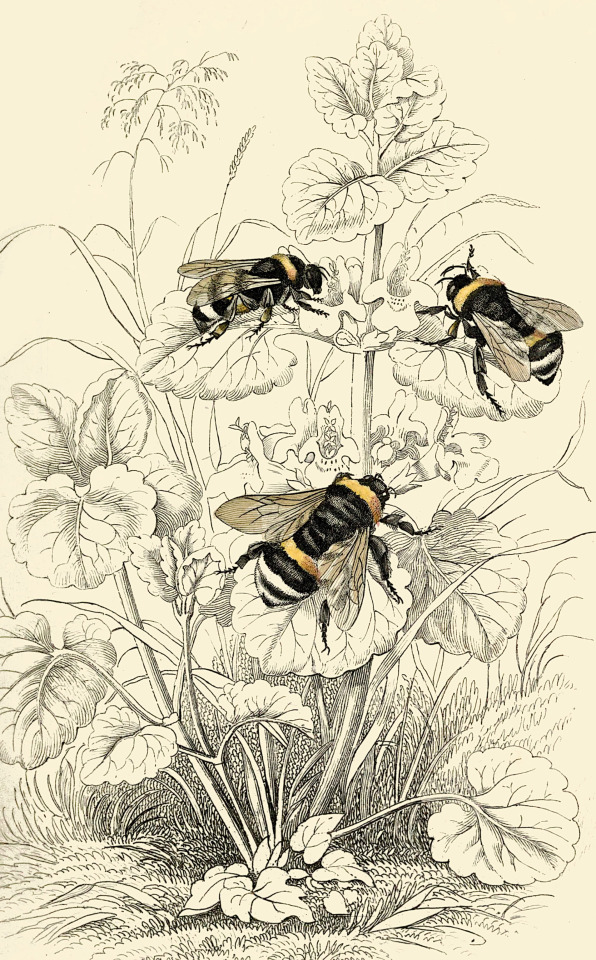
The naturalist's library - Sir William Jardine - 1833 - via Internet Archive
4K notes
·
View notes
Text
I am once again reminding people that Vocaloid and other singing synthesizers are not the same as those AI voice models made from celebrities and cartoon characters and the like.
Singing synthesizers are virtual instruments. Vocaloids use audio samples of real human voices the way some other virtual instruments will sample real guitars and pianos and the like, but they still need to be "played", per say, and getting good results requires a lot of manual manipulation of these samples within a synthesis engine.
Crucially, though, the main distinction here is consent. Commercial singing synthesizers are made by contracting vocalists to use their voices to create these sample libraries. They agree to the process and are compensated for their time and labor.
Some synthesizer engines like Vocaloid and Synthesizer V do have "AI" voice libraries, meaning that part of the rendering process involves using an AI model trained on data from the voice provider singing in order to ideally result in more naturalistic synthesis, but again, this is done with consent, and still requires a lot of manual input on the part of the user. They are still virtual instruments, not voice clones that auto-generate output based on prompts.
In fact, in the DIY singing synth community, making voice libraries out of samples you don't have permission to use is generally frowned upon, and is a violation of most DIY engines' terms of service, such as UTAU.
Please do research before jumping to conclusions about anything that remotely resembles AI generation. Also, please think through your anti-AI stance a little more than "technology bad"; think about who it hurts and when it hurts them so you can approach it from an informed, critical perspective rather than just something to be blindly angry about. You're not helping artists/vocalists/etc. if you aren't focused on combating actual theft and exploitation.
#long post#last post I'm making about this I'm tired of commenting on other posts about it lol#500#1k
2K notes
·
View notes
Text

The Least Horned Owl, Strix pulchella [Pl. 22] | The Naturalist's Miscellany v.1 | Biodiversity Heritage Library | Flickr
#george shaw#frederick polydore nodder#illustration#vintage illustration#scientific illustration#bird identification#strigidae#otus scops#eurasian scops owl
213 notes
·
View notes
Photo

🦭 The naturalist's library. Edinburgh, W. H. Lizars; [etc., etc.]1833-.
43 notes
·
View notes
Text
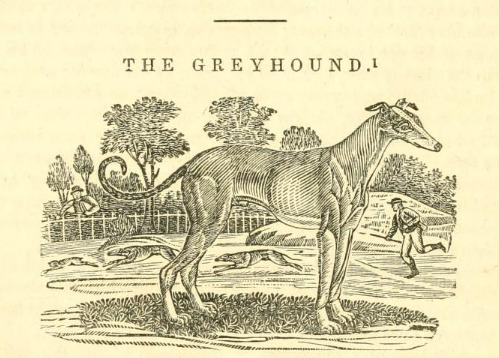
The Naturalist's Library (1852) A. A. Gould
#engraving#engraving illustration#engraving art#1800s#vintage#vintage art#victorian#victorian era#dog#dogs#greyhound#animal#animals#etching#woodcut#etching art#woodcut art#woodcut illustration
221 notes
·
View notes
Text

'Annulated Butterfly of New South Wales' taken from 'The Naturalist's Pocket Magazine' (1802).
Natural History Museum Library, London
archive.org
79 notes
·
View notes
Text
Thank you so much for the tag @raflesia65! 😘
Tagging @esolean @valyrra @localravenclaw @wingedwartigers @lanabenikosdoormat @ominisss @slothssassin and anyone else who wants to play!
Rules: Go to pinterest and type in “celebrity,” “outfit,” “quote,” and “aesthetic” and post the first image in each category that fits your vibe.

Celebrity: Julia Roberts
Outfit: Sweater dress with knee high boots (this is what I wear like every day in the winter TBH. just usually longer)
Quote: if it makes you happy then it is not a waste of time.
Aesthetic: Academia, naturalist library
156 notes
·
View notes
Note
I'm going to southern france next month. Any suggestions for common birds to keep an eye out for? Our library system had one book on birds of Europe and it's huge and overwhelming.
Birds of the Camargue
I do not have a way of knowing what birds are common in that region, versus what is occasional, but I can put you in touch with some resources, along with a few of the cooler birds from that region.
(*we messaged earlier about what are of southern France they would be visiting.)
Some good links:
Birds of Camargue - The Birds of Camargue (oiseaux-de-camargue.fr)
Accueil - Bureau des Guides Naturalistes - Site officiel (guide-nature.fr)
Birdwatching in the Camargue (surfbirds.com)
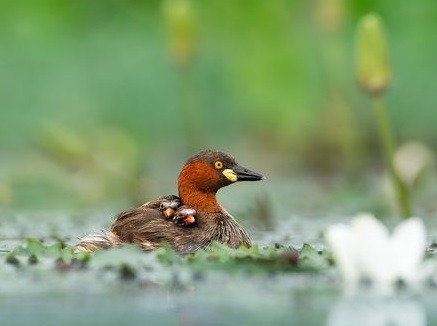
Little Grebes aka Dabchicks (Tachybaptus ruficollis), family Podicipedidae, order Podicipediformes
Photograph by Mainak Halder

Bearded Reedling aka Bearded Tit (Panurus biarmicus), family Panuridae, order Passeriformes
photograph by Carlo Galliani https://www.facebook.com/carlo.galliani.58

Greater Flamingo (Phoenicopterus roseus), family Phoenicopteridae, order Phoenicopteriformes
photograph by Carlo Pelagalli
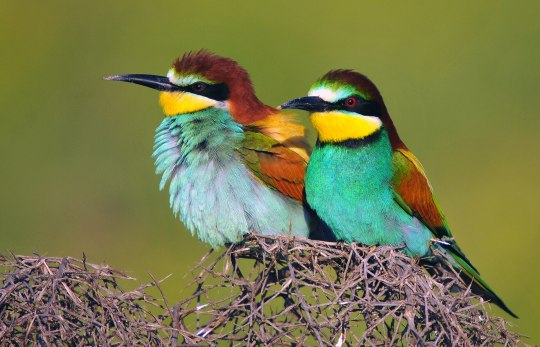
European Bee-eater (Merops apiaster), family Meropidae, order Coraciiformes
photograph by Dûrzan Cîrano
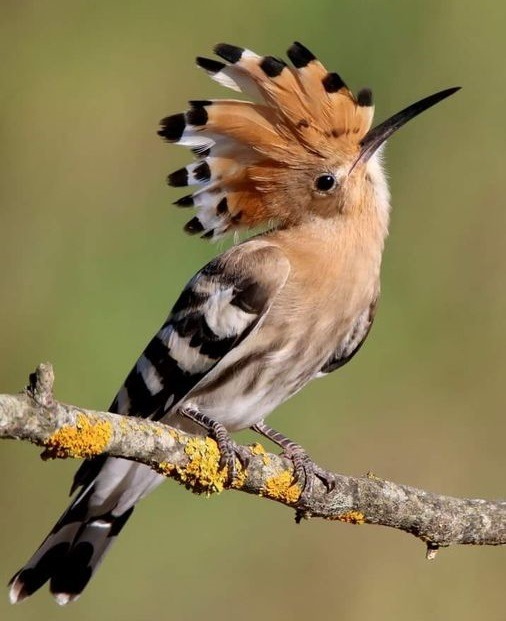
Eurasian Hoopoe (Upupa epops), family Upupidae, order Bucerotiformes
photograph by João Gomes
126 notes
·
View notes
Text

The naturalist's library - vol. 1 - Sir William Jardine - 1833 - via Internet Archive
351 notes
·
View notes
Text
Have you ever wanted to know more about the mason spider, the stag beetle, eel power (??), or any other plant, animal, or mineral? Charles Rainsford is here to help! Rainsford was an 18th century British army officer, fellow of the Royal Society, and alchemist, who collected books about his interests. His collection included this Naturalist's Manual, now UPenn Ms. Codex 1708, which was translated from French by Rainsford himself. We'll be posting his books under the tag #RainsfordDay, so watch for more this year!
🔗:
#RainsfordDay#Charles Rainsford#nature#natural history#natural philosophy#dictionary#animals#mason spider#stag beetle#alchemy#18th century#19th century#book history#rare books
33 notes
·
View notes





